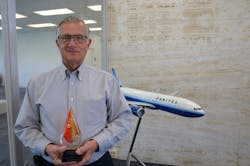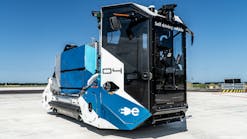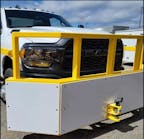September 7, 1965; nearly 51 years.
Dick Cloud started at United Airlines in the autumn of 1965, has been with the Chicago-based airline ever since and has no plans of leaving anytime soon.
Cloud returned to Chicago in the mid-1960s following his service with the United States Air Force and had been interviewing at firms like IBM and Teletype before interviewing at Nuclear Chicago. It would be his last job interview.
On his way out of the Nuclear Chicago interview, Cloud saw a United Airlines sign advertising jobs for ramp servicemen at $2.50 per hour.
“I drove right into the airport,” Cloud says from a United Airlines conference room. “No security, no nothing. I walked in, introduced myself and they said ‘fill out the application.’
“I was hired on the spot.”
Cloud went from ramp serviceman to building maintenance mechanic in a matter of months and within five years had moved up to become a maintenance planner. Today Cloud is United’s Engineering and Safety Manager Facilities and GSE.
“I’m looking around at these guys,” Cloud says of his early colleagues. “One of them was a tailor, but he belonged to the Masons and the company president was head of the Masons.
“I had another guy that was a spray painter. He could do these tops and these desks and sand them down and spray them with lacquer and varnish and so forth. They could hang pictures and they could do baseboard, but nobody could read a wiring diagram. Nobody could troubleshoot a jetway. Nobody could troubleshoot a bag system conveyor, but me, so I became the jetway guy.”
And you can believe Cloud’s recollections. He’s known throughout the aviation industry for his photographic memory, a trait that has been undoubtedly helpful, but the reputation for having one can prove to be a challenge.
“I can remember names and faces, but I cannot put names and faces together,” Cloud says. “But I can tell you every single solitary wingspan of an airplane and what the cell heights are, the gearbox ratios and all that technical stuff.
“That has been a godsend, and that’s the reason I get called all the time.”
Cloud gets a lot of calls. Since 1968, he’s been involved with every new fleet United has introduced. In November of last year, United’s Hemispheres Magazine called Cloud “The Master of the Jet Bridge,” in recognition of his 50 years of service.
“His knowledge of aircraft, airport terminal and ground service equipment requirements is unparalleled by anyone working in the industry today,” Andrew Alexander, a colleague at United told Hemispheres of Cloud’s expertise. “He is a walking encyclopedia of the airline industry.”
The Master of the Jet Bridge
It has been a life of learning for Cloud, who has seen GSE transform from actual hay carts to highly specialized equipment and immense shifts in both size and power.
“It was based on what the farming industry was doing,” Cloud says. “We didn’t actually have farm tractors, although with the Kubotas and the stuff we’re going back to today, it’s starting to look like we do have a small farm.”
The jet bridge, however, has been Cloud’s bread and butter for decades. When Cloud started his tenure as a maintenance mechanic, United had just 18 jet bridges, 12 of which were out of service following a strike.
Within two days Cloud had all 18 bridges working again and a department asking how he was able to get it done so quickly.
“It was the same problem with all of them,” Cloud says. “You’ve got motor generator sets and they’ve got commutators, and guess what? They’re all oxidized because they’ve been sitting here for 43 days and you’re not getting any power. That’s the reason only one wheel’s working. All I had to do was clean up the commutators and they all drive now.”
Today Cloud is solving problems like the one he solved in 1968 all over the world. As airplanes continue to grow in all dimensions, airports stay the same size. Much of Cloud’s work today includes fitting more and more pounds of airplane in the same size bag without losing gate space at landlocked airports.
“I have a saying that I’ve said for years: ‘There’s new technology and there’s new people but there are no new problems,’” Cloud says. “It’s those challenges that make this job so interesting, but so much more difficult to do today than what it was when I started doing it 50 years ago."
Those challenges include the comparatively shrinking real estate available on airport ramps with larger airplanes. Cloud says that’s the biggest challenge he faces at this point in his career. Airports in the United States and around the world are trying to fit the same number of Airbus A380s at their gates as they fit DC-10s back when these airports were designed in the 1960s, '70s and '80s.
“A lot of airports are taking over the responsibility of designing the gates, and they’re making them all common-use gates,” Cloud says. “You lose so much capability doing that. How can I ensure that if I’m going to put a 787 there that they put the ground power unit in and the air conditioning unit and the capabilities on the boarding bridge to service that airplane?”
And when Cloud is part of a redesign or buys a new bridge, he’s lucky if he can get one when he needs it.
United got the last two slots for bridge production with JBT for 2016. The next available delivery is April 2017. In response to the scarcity, Cloud has a $60 million refurb plan to outpace bridge production. Have we mentioned he’s already been doing this for 50 years?
“I’ve taken a 40-year plan for 400 bridges, 10 bridges a year, but if your bridge is 25-years-old, I’ll do a modification to them with all brand new cabs, electrical controls, upgrades, new tunnel rollers,” Cloud says. “I’ll extend the life of a bridge up to at least 40 years.”
Feast and Famine in Aviation
When GSE purchasers can get on the list for equipment, there are fewer and fewer people making it, according to Cloud.
“In this industry, there’re fewer manufacturers than we had to deal with for 50 years,” he says. “If you went back before 9/11, we probably have half the number of manufacturers. We probably have half the number of airlines that we had at that point in time.”
Consolidation and extended business cycles have left the aviation industry an industry of legacy, according to Cloud. There’s direct lineage from when he started, to who is still making GSE. The names and the faces continue to change, but “because of their name and their capabilities and being able to keep up with the trends in the industry, it has kept them alive and kept the airlines alive.”
Today, aviation is feasting. Money is flowing and the good times are rolling. Yet hiring lags. “We can’t guarantee that next year,” Cloud says. “So how far out do you plan?”
Oddly enough, Cloud’s job gets more difficult when the tide is rising across the industry – he can’t get the equipment he needs when he needs it.
“The famine you can almost deal with,” Cloud says. “The feast is more difficult to deal with because now we’re starting to spend money and everybody’s starting to spend money, and nobody has the production facilities or the raw material capabilities.”
When United wants to order 23 bridges manufacturers have told Cloud that he can get two in the quarter and five for the year, but there’s no more production left.
The Calm in the Storm
“Probably the biggest challenge and one of the most interesting tasks I had when I was called on day four of Hurricane Katrina to be part of the very first evacuation flight out of there with an airport that had no communications, no power,” Cloud says. “We flew in with a 757, I had two field service mechanics, and we were going to bring as many people as we possibly could get on that first evaluation flight out of there. It ended up being 104 people coming back to Chicago.
“Those were the first people who came off of the rooftops, who had not seen anything that you can call civility in four days. I had 26 wheelchair passengers and no boarding bridge, no power whatsoever, but one of our local FBOs down there got a passenger stand. We put the passenger stairs up to door number 2 and I operated 26 wheelchair passengers up and down to door number 1 with the old wheelchair pallet to get those people on the airplane.”
With no control tower, no cell phones and no power, Cloud and his team kept in touch with the FAA through global support radios.
“We bring them back to Chicago and ABC comes on and I’m on Good Morning America the next morning.”
Because the trip was such a success, Cloud and the United team were sent to get more Hurricane Katrina evacuees following the storm. The second trip gave them more than four hours on the ground so they took the time to get batteries replaced in some of their ground equipment as well as get a jet bridge running for all evacuation flights to use. Cloud sent a mechanic back down there and they had three more bridges running within two days.
Three weeks later Cloud was asked to restore the airport to working order so that United could be the first airline to start operating from New Orleans again.
“I had 14 trips over seven months,” Cloud says. “I took all my contractors starting in week three, I flew some of them through Atlanta. I flew some of them through Memphis. I had two guys drive down with a four-by-four panel truck.”
Three weeks later, Cloud had airplanes coming into New Orleans. The boarding bridges were rebuilt and all the damaged ones were replaced.
“I had all brand new carpeting in the boarding area,” Cloud says. “Everything was clean and sanitized.”
Downstairs, however, the United work area was a disaster. Everything, from the floor tile to the ceiling was waterlogged. Cloud was hanging drywall himself, even with a team including a carpenter, three carpet installers, an electrician and five field service mechanics. In all, their New Orleans renovation project took over seven months.
Cloud says it was the most satisfying project of his storied career.
“Because I was given the full, total authority and the capability to just do what you got to do,” he says. “Get it done. That was the most satisfying thing.”
The recognition is nice, Cloud says, but it’s the people you get to work with that keeps him around the ground support industry and aviation as a whole.
“Everybody says, ‘you’ve been here for 50 years, why are you still doing this?’ Well, one of the reasons is because I still can,” Cloud says. “I still enjoy it. I enjoy the challenges. One thing about this job and in this industry is that one person can make a difference.”






